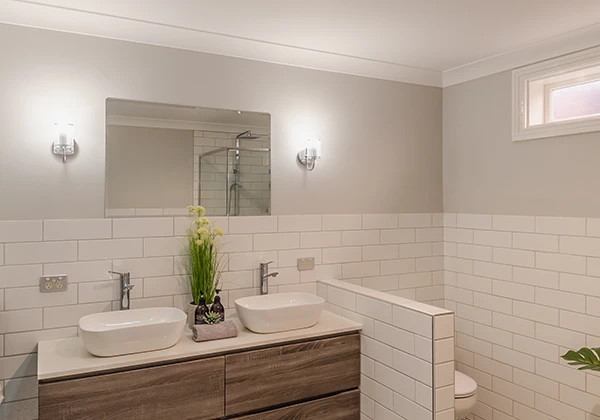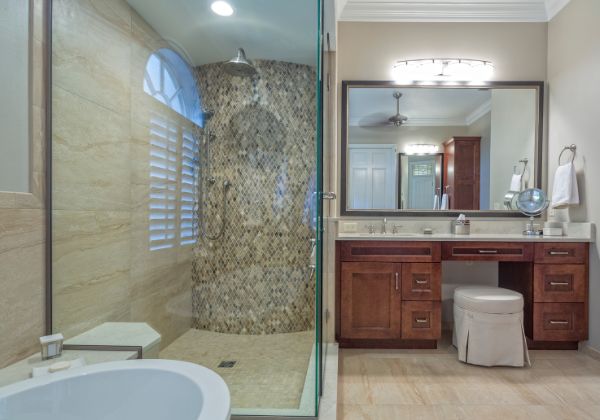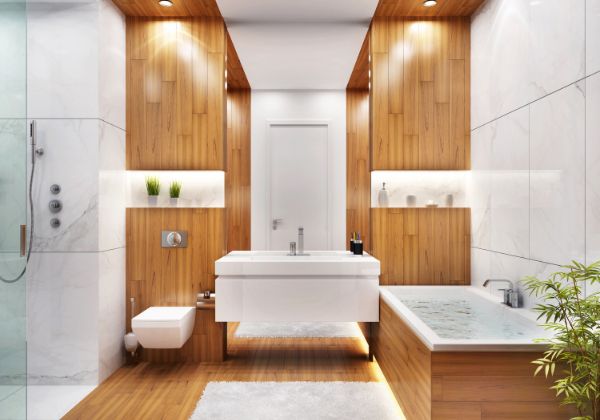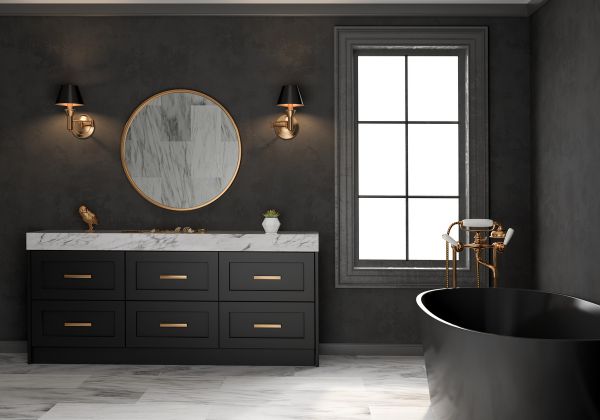Avoid Common Bathroom Lighting Mistakes

Irrespective of whether your bathroom is your oasis or a shared bathroom that receives a ton of traffic, one thing is sure: it needs good-quality lighting. While everyone knows a bathroom needs ample lighting, getting it right can be tricky. Bathrooms are some of the smallest rooms in the house, so choosing where to hang the sconces, where to place the ceiling lights, or where to place the light switches can become difficult.
If trying to improve your bathroom lighting is making you feel overwhelmed, here are a few common bathroom lighting mistakes that can be easily avoided.

Bathroom Lighting Mistake #1: Too Little Lighting
Many homeowners think that one overhead light or a single sconce above a mirror may be enough to illuminate a small bathroom. However, no matter the bathroom size, more than one light fixture is usually required. Think of it this way: if you had just a sconce light over a mirror, it would give you excellent shadow-free light for tasks like putting on makeup or shaving at the mirror, but may not help in providing enough ambient light. Conversely, an overhead light might provide ample ambient light but will fall short and not provide a shadow-free light when using the mirror.
Solution: Layer Your Lighting
This technique uses multiple lighting types to create a space that is well-lit and balanced. It provides ambient lighting for the entire room and task lighting for a specific area. You may also want to add a few accent lighting options for spots in the bathroom that you want to highlight.
Our Experts Suggest
When planning to improve bathroom lighting, especially for the shower area, always look for the wet-location listed options. Steam showers may also need a different kind of light, so look for fixtures that are recommended for your specific application.

Bathroom Lighting Mistake #2: Overlooking Color Temperature and CRI
In most cases, you will easily find information about the color temperature and color rendering index (CRI), brightness, and wattage. This information is essential to note as it describes the color of the white light that the fixture gives out.
Color temperature is usually measured in Kelvin (K), and the lower the color temperature, the warmer (redder) the color of the light appears. Higher color temperature values indicate that the light source will emit a cooler (bluer) light. Here are a few examples of color temperature values for common light sources.
- Candlelight: 1800K
- Daylight at noon on a snowy day: 6500K
- Incandescent bulb: 2700K
- Halogen Bulb: 3000K
Color Rendering Index or CRI refers to how true to life the light source's color is when compared to a whole spectrum source of the same color temperature. The light with lower CRI does not render color as accurately, which dulls the room's color or gives it a strange tint. For example, the older fluorescent lights that sometimes make a room look sickly or not quite right are perfect representations of lights with low CRI.
If you install lights with low CRI in the bathroom, you may end up with a space that looks unnatural and makes mirror tasks more difficult. At the same time, choosing lighting with a very high or extremely low color temperature can give the objects in the space a blue or amber tint, making it difficult for you to see the correct color, ultimately changing the overall look of the room.
Solution
Get familiar with the way lights look at different color temperatures; while different people will have different preferences, most usually choose lights within the range of 2700K and 3000K, as this is the range that they are familiar with and comfortable with.
Our Experts Suggest
If you are looking for a cozier feel for the room, choose lights that are around 2700K. These are also flattering to a warmer color palette and skin tones. Choose these options when you want to improve the importance of bathroom lighting for a powder room where you or your guests want to check their makeup or wash their hands.
If you want the room to have a crisper, brighter feel, pick a light closer to 3000K. This is also a great option for the primary bathroom, giving excellent color reproduction when applying makeup and showcasing the best bathroom lighting ideas.

Bathroom Lighting Mistake #3: Dismissing Dimming
This is the bathroom lighting mistake that is most commonly seen, especially in those spaces that rely on a single light source in the bathroom. A dimmable light is perfect for a versatile space such as a bathroom. You can use it at its full intensity when applying your makeup or shaving in the morning and keep it at its dimmest at night to avoid disrupting your circadian rhythm.
Solution
Consider adding dimmers or dimmable lights to your bathroom. This has the added bonus of giving you excellent ambient lights when you want to enjoy your long, rejuvenating bath or shower at the end of a long day.
Our Experts Suggest
If you find that choosing the right light for your home is more complicated than you anticipated, it is best to talk to bathroom remodeling professionals who will help you with bathroom lighting installation services and ensure the right lighting solutions for your home.
Now that you know the common bathroom lighting mistakes, here are a few things that can help you improve bathroom lighting in no time. Focus on layering the light in your bathroom, choose lights that can be dimmed, choose a light color temperature that you are comfortable with, and consult with lighting experts to get the best options for your home.
Contact us at Remodel Your Home to find out how we can help you with bathroom lighting installation services and upgrade the entire look of your home. Our best-in-class contracting service, combined with affordable pricing, can help you with any home improvement projects you may have in mind.

Remodel Your Home
We are a leader in the home improvement space with over 20 years of experience pairing homeowners with construction experts.
About Us